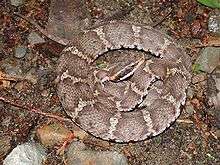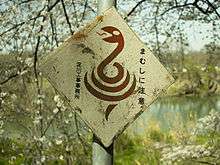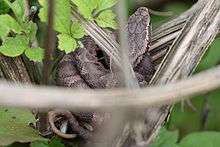Mamushi
| Gloydius blomhoffii | |
|---|---|
 | |
| Scientific classification | |
| Kingdom: | Animalia |
| Phylum: | Chordata |
| Class: | Reptilia |
| Order: | Squamata |
| Suborder: | Serpentes |
| Family: | Viperidae |
| Genus: | Gloydius |
| Species: | G. blomhoffii |
| Binomial name | |
| Gloydius blomhoffii (H. Boie, 1826) | |
| Synonyms | |
| |
Gloydius blomhoffii, commonly known as the mamushi,[2] Japanese moccasin, Japanese pit viper, Qichun snake or Japanese mamushi,[3] is a venomous pitviper species found in China, Japan, and Korea. There are four subspecies including the nominate subspecies described here.[4]
This species and the Okinawan habu are the most venomous snakes in Japan.[5] Every year, 2000–3000 people in Japan are bitten by a mamushi. Bitten victims typically require one week of treatment in a hospital. Severe bites require intensive care, and approximately 10 victims die annually.[6][7]
Etymology
The specific name, blomhoffii, is in honor of Jan Cock Blomhoff, who was director of the Dutch trading colony in Nagasaki, Japan from 1817 to 1824.[8]
Description
The average length of mature individuals is 45–81 cm (17¾-31⅞ inches); the longest specimen ever recorded had a length of 91 cm (36 in).[2]
The body pattern consists of a pale gray, reddish-brown, or yellow-brown background, overlaid with a series of irregularly-shaped lateral blotches. These blotches are bordered with black and often have lighter centers. The head is dark brown or black, with beige or pale-gray sides.[2]

Common names
The common name in English is mamushi,[2] or Japanese mamushi.[3] The common name in Japanese is mamushi (蝮). In Korea, it is known as 살무사 (salmusa) or 살모사 (salmosa). In China, it is known as the Qichun snake (七寸子) or soil snake/viper (土巴蛇、土蝮蛇、土夫蛇、土公蛇).
Geographic range
It is found in China, Japan, and Korea. It is the most common snake in Japan.[9] According to Gloyd and Conant (1990), there is no evidence to support claims that this species occurs in the Ryukyu Islands. The type locality given is "Japan."[1]
Habitat
It occurs in a range of habitats, including swamps, marshes, meadows, open woodland, rocky hillsides, and montane rock outcroppings.[2]
Diet

It is typically an ambush predator that uses its excellent camouflage to hide itself in vegetation or leaf litter. It hunts and eats mainly rodents, but also small birds, lizards, and insects. It is often found in and around farmland due to the associated rodent populations.[2]
Venom
Characteristics
The venom of this species varies very little among Japan, China, and Korea in terms of both its potency and its effects.[10] According to Yoshimitsu (2005), this species and the Okinawan habu, another pitviper, are the most venomous snakes in Japan.[5] The venom's lethality as measured by LD50 in mice following intraperitoneal injection is in the range 0.3 mg/kg[11] to 1.22 mg/kg.[12] The venom mostly contains haemolytic toxins, but it also has two neurotoxins—an alpha-toxin that is a post-synaptic inhibitor and a beta-toxin that is a pre-synaptic inhibitor.[12] Because the beta-toxin acts pre-synaptically, its effects cannot be blocked or treated by anticholinesterases.[12] The venom contains an anticoagulant, mamushi L-amino-acid oxidase (M-LAO).[13] It also contains the peptide ablomin which is highly similar in amino acid sequence to that of the venom, helothermine, of the beaded lizard (Heloderma horridum).[14]
Treatments for envenomations
There is an effective antivenom manufactured in both Japan and China.[10] Its effectiveness is increased when co-administered with a serine protease inhibitor such as FOY (see, e.g. Camostat).[15] In common with many other venomous snakes, the mamushi is highly resistant to its own venom because of various neutralising factors present in its sera including phospholipase A2 (PLA2) inhibitors; these and other inhibitors are the target of antivenom development.[16]
Every year, 2000-3000 people in Japan are bitten by mamushi, severe bites require intensive care, and approximately 10 victims die.[6] There have been case reports of renal failure,[17] visual disturbances,[18] palsy, and miscarriage in pregnant women.[19]
In one study in Japan, mamushi bite victims required a median duration of 7 days of hospital treatment followed by a median of 31 days of out-patient treatment; the time to achieve a full recovery was even longer, taking up to several months.[7] The treatment protocol involved incision of the wound for exclusion of the venom, and injection of mamushi antivenom.[7]
Subspecies
| Subspecies[4] | Taxon author[4] | Common name[20] | Geographic range[2] |
|---|---|---|---|
| G. b. blomhoffii | (H. Boie, 1826) | Japanese mamushi | Japan, including most of the smaller islands. |
| G. b. brevicaudus | (Stejneger, 1907) | Short-tailed mamushi | Northeast China and the Korean Peninsula. |
| G. b. dubitatus | (Gloyd, 1977) | Tung Ling mamushi | Restricted to Hebei Province, China. |
| G. b. siniticus | (Gloyd, 1977) | Yangtze mamushi | Type locality: China, from Shandong, Jiang Su and Anhui provinces, south to the Ch'ang Chiang Basin and eastern Sichuan, Jiangxi and Hunan. |
Taxonomy
There are five subspecies—the four mentioned in the table above, plus A. b. ussuriensis, which is found in Russia.[20] However, the fifth subspecies has also been considered a species: Gloydius ussuriensis.[1][2]
This species is similar to the cottonmouths and copperheads (Agkistrodon sp.) of the Americas, and it was long considered part of the same group (see synonymy).[1]
See also
- List of crotaline species and subspecies
- Crotalinae by common name
- Crotalinae by taxonomic synonyms
- Snakebite
References
- 1 2 3 4 McDiarmid RW, Campbell JA, Touré T. 1999. Snake Species of the World: A Taxonomic and Geographic Reference, Volume 1. Washington, District of Columbia: Herpetologists' League. 511 pp. ISBN 1-893777-00-6 (series). ISBN 1-893777-01-4 (volume).
- 1 2 3 4 5 6 7 8 Mehrtens JM. 1987. Living Snakes of the World in Color. New York: Sterling Publishers. 480 pp. ISBN 0-8069-6460-X.
- 1 2 Gumprecht A, Tillack F, Orlov NL, Captain A, Ryabov S. 2004. Asian Pitvipers. First Edition. Berlin: Geitje Books. 368 pp. ISBN 3-937975-00-4.
- 1 2 3 "Gloydius blomhoffii". Integrated Taxonomic Information System. Retrieved 19 May 2007.
- 1 2 Yoshimitsu, M (2005). "Animal and Snake Bites". Japanese Journal of Pediatric Surgery (in Japanese). 37 (2): 207–15. ISSN 0385-6313.
- 1 2 Okamoto, Osamu; Oishi, Masaki; Hatano, Yutaka; Kai, Yoshitaka; Goto, Mizuki; Kato, Aiko; Shimizu, Fumiaki; Katagiri, Kazumoto; Fujiwara, Sakuhei (2009). "Severity factors of Mamushi (Agkistrodon blomhoffii) bite". The Journal of Dermatology. 36 (5): 277–83. PMID 19382998. doi:10.1111/j.1346-8138.2009.00638.x.
- 1 2 3 Shigeta, Masatoshi; Kuga, Takayuki; Kudo, Junichi; Yamashita, Akimasa; Fujii, Yasuhiro (2007). "Clinical Study of Mamushi Viper Bites in 35 Cases". Journal of the Japanese Association of Rural Medicine. 56 (2): 61–7. doi:10.2185/jjrm.56.61.
- ↑ Beolens B, Watkins M, Grayson M. 2011. The Eponym Dictionary of Reptiles. Baltimore: Johns Hopkins University Press. xiii + 296 pp. ISBN 978-1-4214-0135-5. (Gloydius blomhoffi, p. 28).
- ↑ Ameno, Setsuko; Ameno, Kiyoshi; Fuke, Chiaki; Kiryu, Takahiro; Ijiri, Iwao (1990). "IgG subclass distributions of anti-horse serum antibodies and natural venom-antibodies produced in response to antivenom injection or snake bite in humans". Toxicon. 28 (3): 347–50. PMID 2343468. doi:10.1016/0041-0101(90)90070-N.
- 1 2 Fukuda, Tadashi; Iwaki, Masaaki; Hong, Seung Hwa; Oh, Ho Jung; Wei, Zhu; Morokuma, Kazunori; Ohkuma, Kunio; Dianliang, Lei; Arakawa, Yoshichika; Takahashi, Motohide (2006). "Standardization of Regional Reference for Mamushi (Gloydius blomhoffii) Antivenom in Japan, Korea, and China". Japanese Journal of Infectious Diseases. 59 (1): 20–4. PMID 16495629.
- ↑ Hung, Yao-Ching; Sava, Vasyl; Hong, Meng-Yen; Huang, G.Steven (2004). "Inhibitory effects on phospholipase A2 and antivenin activity of melanin extracted from Thea sinensis Linn". Life Sciences. 74 (16): 2037–47. PMID 14967198. doi:10.1016/j.lfs.2003.09.048.
- 1 2 3 Igari, R; Iseki, K; Abe, S; Syoji, M; Sato, M; Shimomura, K; Hayashida, A; Sugiura, A; Iwashita, Y; Midorikawa, S (2010). 症例報告 マムシ咬傷により複視・眼瞼下垂をきたした1例 [Binocular diplopia and ptosis due to snakebite (Agkistrodon blomhoffi "mamushi")--a case report]. Brain and Nerve (in Japanese). 62 (3): 273–7. PMID 20297733. Archived from the original on 2013-09-05.
- ↑ Sakurai, Yoshihiko; Shima, Midori; Matsumoto, Tomoko; Takatsuka, Hideo; Nishiya, Katsumi; Kasuda, Shogo; Fujimura, Yoshihiro; Yoshioka, Akira (2003). "Anticoagulant activity of M-LAO, l-amino acid oxidase purified from Agkistrodon halys blomhoffii, through selective inhibition of factor IX". Biochimica et Biophysica Acta (BBA) - Proteins and Proteomics. 1649: 51. doi:10.1016/S1570-9639(03)00157-2.
- ↑ Yamazaki, Yasuo; Koike, Hisashi; Sugiyama, Yusuke; Motoyoshi, Kazuko; Wada, Taeko; Hishinuma, Shigeru; Mita, Mitsuo; Morita, Takashi (2002). "Cloning and characterization of novel snake venom proteins that block smooth muscle contraction". European Journal of Biochemistry. 269 (11): 2708–15. PMID 12047379. doi:10.1046/j.1432-1033.2002.02940.x.
- ↑ Watanabe H, Nagatake T, Matsumoto K, Sakamoto T, Rikitomi N, Hirano E. 1992. Effectiveness of protease inhibition in severe mamushi bite. Procs. XXXIV Annual Meetings of Japan Society of Tropical Medicine, 25–26 Nov 1992, Nagasaki, p.75. Preprint. Also published by same authors as Jpn J Trop Med Hyg, 21(1):39–92, 1993.
- ↑ Motou K, Yoshida A, Hattori S, Ohno M. 2003. A trial of muscle necrosis prevention by T. flavoviridis venom. Kagoshima University Journal of Medicine. 23:15–24.
- ↑ Otsuji Y, Irie Y, Ueda H, Yotsueda K, Kitahara T, Yokoyama K, Higashi Y. 1978. A case of acute renal failure caused by Mamushi (Agkistrodon halys) bite. Medical J Kagoshima Univ (in Japanese) 30:129–135.
- ↑ Takeshita, T; Yamada, K; Hanada, M; Oda-Ueda, N (2003). "Case report: Extraocular muscle paresis caused by snakebite". Kobe Journal of Medical Sciences. 49 (1–2): 11–5. PMID 12698017.
- ↑ Nasu, Kaei; Ueda, Tami; Miyakawa, Isao (2004). "Intrauterine Fetal Death Caused by Pit Viper Venom Poisoning in Early Pregnancy". Gynecologic and Obstetric Investigation. 57 (2): 114–6. PMID 14691344. doi:10.1159/000075676.
- 1 2 Gloyd HK, Conant R. 1990. Snakes of the Agkistrodon Complex: A Monographic Review. Society for the Study of Amphibians and Reptiles. 614 pp. 52 plates. LCCN 89-50342. ISBN 0-916984-20-6.
Further reading
- Boie, H. 1826. Merkmale eineger japanischer Lurche. Isis von Oken 19: 203-216. (Trigonocephalus blomhoffii, pp. 214–215).
External links
| Wikimedia Commons has media related to Gloydius blomhoffii. |
- Gloydius blomhoffii at the Reptarium.cz Reptile Database. Accessed 8 April 2014.
- Gloydius blomhoffii at the Encyclopedia of Japanese Reptiles. Accessed 20 December 2007.